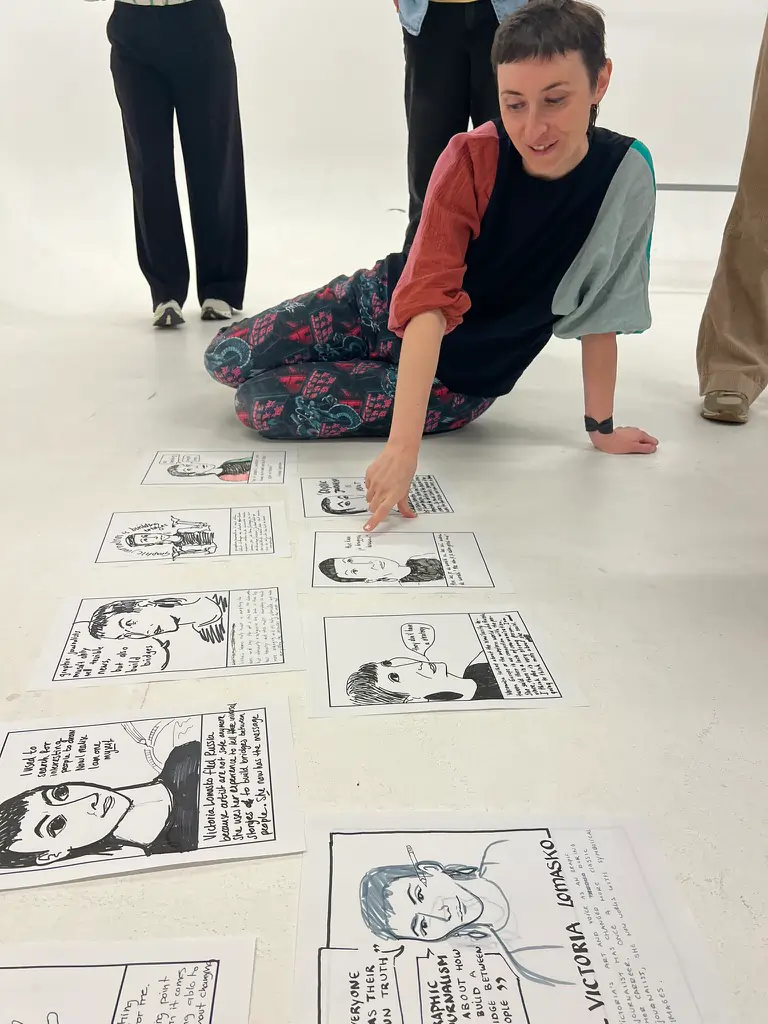Drawn To Freedom Part Two – Victoria Lomasko

Drawn To Freedom, organized by Stichting Cultuurkoepel was a multi faceted co-creation project that took place in the Koepel in Haarlem in two parts: in the last weekend of May, there was a newsroom where stories were being visualized by graphic journalists in conversation with Haarlemmers for whom freedom is not a given. Most of the stories were made in the newsroom in the presence of the interviewee. This approach is different from usual journalistic practices, where the journalist is the only one in charge of the story. The protagonists of the story are ordinary people, with whom many others can identify – who have an extraordinary story to tell. These are also the kind of stories Russian artist and graphic journalist, Victoria Lomasko is interested in and uses in her graphic reportages.
The second part of the project took place in September: On September 16 each year, the Koepel ‘celebrates’ the birthday of Hannie Schaft, a well known resistance fighter from Haarlem, who was imprisoned in the Koepel prison during the second World War.
Stichting Cultuurkoepel invited Victoria Lomasko to make a mural in the Koepel, that is part of the tribute to Hannie Schaft. Like Hannie Schaft at that time, Victoria lived in a country where freedom of speach was under pressure and after Russia invaded Ukraine, she was forced to flee the country because she was in danger to go to jail for her activist work.

For two weeks in September, she worked on the mural called Landscape of the 21st Century. She painted the Media Wheel that is spinning. We see people who are suffering in wars – e.g. Ukraine, Gaza – getting attention in the media. Then they fall and turn into waste because there are new images to flood the social media channels. These images are only fragments of reality, we never see the whole landscape. She also paints a big chandelier that symbolizes Europeans. Europeans do not realize that their happy, carefree lives could change from one moment to the other.


People in Europe often ask her why Russians do not demonstrate against the regime of Putin. She took part in a lot of protest demonstrations herself, but when she noticed that after a demonstration in Belarus the authorities made use of the protests to arrest people, send them to jail or even kill them, it became clear to her that change will not come from street protests, but from people that reach out to each other and get into conversation.

Victoria says: “What if the negative events that are already happening could serve as a stepping stone for collective transformation? We must accept that this historical collapse is a consequence of the fact that, living in the 21st century, we are using scenarios, programs, and tools from the 20th century. Instead of screaming crowds in the streets, there is intellectual work and a cultural revolution. By engaging our imagination, we will create a new vision for the 21st century.
Sleeping Humanity sees a dream in which it is an aggressor, victim, observer, activist and dreamer. Humanity can wake up and understand that it is one. Another interpretation: The figure in the center is you. Each of us can recognize ourselves as the Author and begin today to create the future we desire.”

She has always been interested in the lives of ordinary people. She traveled to several former Sovjet republics to draw reportages and interview people living there. The reportages are collected in a book, that is now published: The Last Soviet Artist. It was finished three weeks before Russia’s invasion of Ukraine. It won the 2022 Free Voice award from PEN Catalan and Prix Couilles au Cul pour le Courage Artistique, Festival de BD d’Angoulême. On the website of Drawing the Times you can read several of the reportages and see the drawings in full color: A Trip to Tbilisi, A Trip to Dagestan, A Trip to Yerevan and a Trip to Kyrgystan.
In 2024, a movie titled Tree of Violence about work the artist on the eve of the war has been distributed by TV-ARTE. People living in the Netherlands can watch it on NPOdoc from October 10.

Part of the project Drawn to Freedom were two masterclasses on graphic journalism, in May, Eva Hilhorst explained how to get in contact with the subject of your story, make them interactive. In September Victoria Lomasko and Eva Hilhorst teamed up and let the participants experience how to express the essence of what you want to convey as a graphic journalist by drawing and writing.






